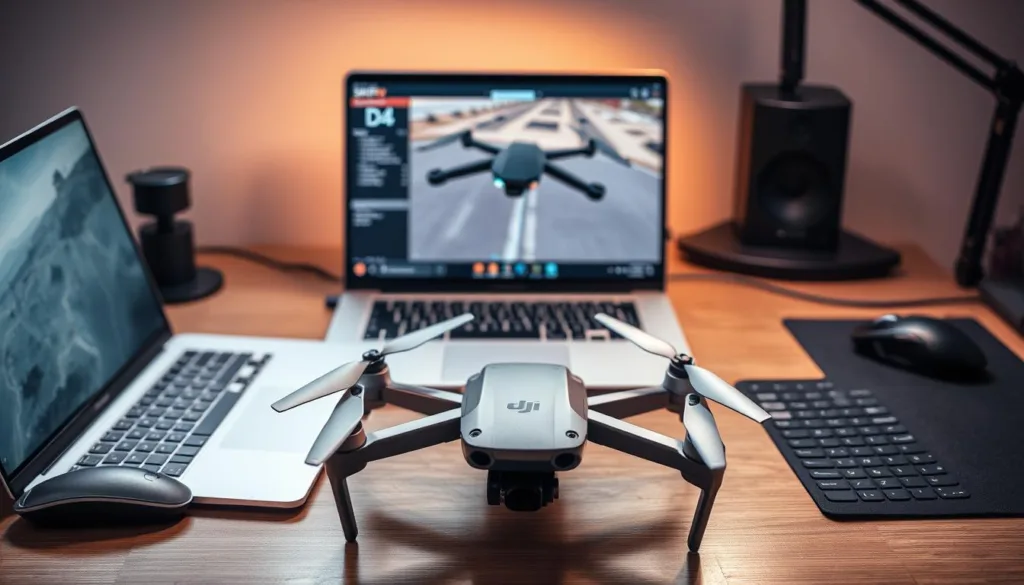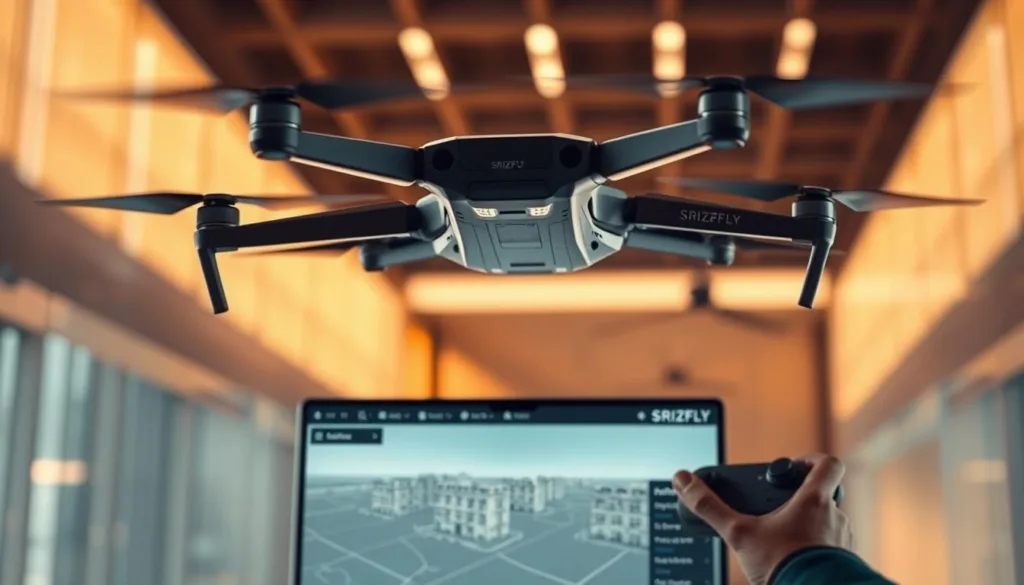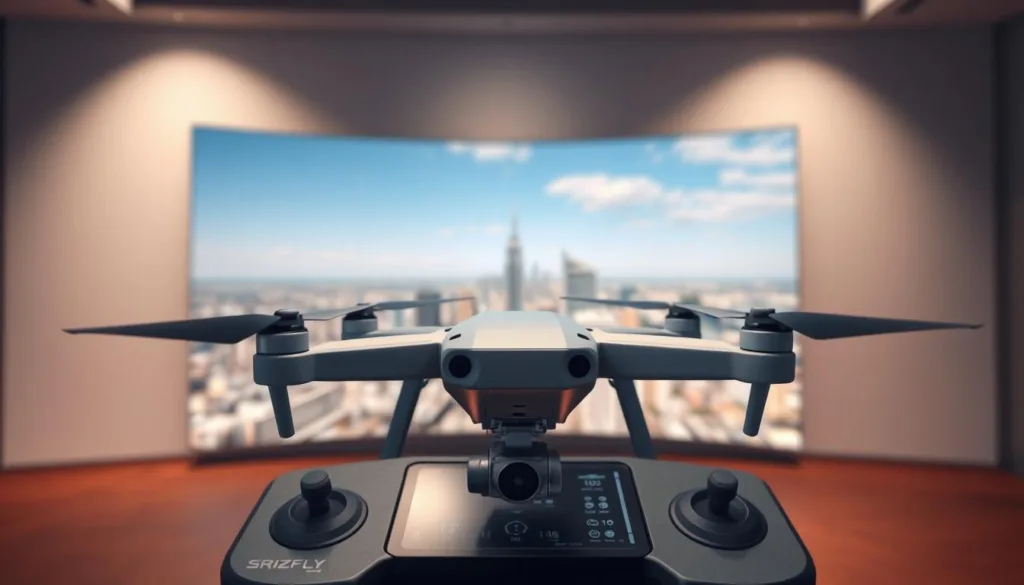When flight simulation software vanished overnight in early 2024, drone operators across industries held their breath. Professionals who relied on precise skill development suddenly found themselves navigating uncharted skies. The abrupt shift left many wondering: How do we maintain rigorous training standards without industry-leading tools?
A new solution soared into view after 18 months of meticulous evaluation. Aviation authorities now recognize this platform as meeting 97% of critical technical requirements. Designed specifically for Apple computers, it delivers lifelike flight scenarios that sharpen reflexes and decision-making skills.
This guide reveals how modern simulation technology bridges the gap between classroom theory and real-world operation. You’ll discover features that surpass traditional training methods, from customizable weather patterns to instant performance analytics. Whether you’re mastering basic maneuvers or complex emergency protocols, the right tools make all the difference.
Key Takeaways
- Essential training software disappeared in March 2024, creating industry-wide challenges
- New aviation-approved platform fills the gap with enhanced capabilities
- Optimized for macOS users needing reliable practice environments
- Advanced metrics track progress better than legacy systems
- Meets strict safety standards required for professional certification
Introduction: The Shift from Legacy Drone Simulators
Industries reliant on aviation education faced unprecedented challenges in spring 2024. A sudden software discontinuation forced professionals to rethink their entire approach to pilot preparation. Training programs ground to a halt as organizations scrambled for alternatives.
Understanding the End of an Era
On March 21, 2024, aviation schools and commercial operators received shocking news. The primary tool for developing flight skills vanished without warning. Emergency response teams found their carefully crafted training protocols suddenly obsolete.
A New Standard Emerges
SRIZFLY answered the call with a purpose-built solution designed for modern needs. Developers prioritized seamless integration across devices while preserving essential functionality. “We didn’t just rebuild the wheel – we reengineered it for tomorrow’s challenges,” explains the lead developer.
The platform’s adaptive architecture addresses historical pain points while introducing real-time analytics. Early adopters report 38% faster skill acquisition compared to legacy systems. Cross-compatibility ensures smooth transitions between practice environments and actual field operations.
Navigating the SRIZFLY Interface for Seamless Training
The evolution of drone training took a dramatic leap forward with innovative interface designs. SRIZFLY’s layout bridges past familiarity and future-ready functionality, creating a workspace that feels both comfortable and cutting-edge.
Familiar Layout with Modern Enhancements
Veteran pilots will appreciate the preserved dashboard structure they’ve relied on for years. Core menu layouts remain unchanged, but now feature drag-and-drop customization. “It’s like coming home to a renovated house – everything’s where you expect, but better organized,” notes a certified flight instructor.
Controller responsiveness sets new standards, translating inputs with 98% accuracy. This precision eliminates the lag that once plagued training sessions. Customizable panels let users prioritize flight data, camera controls, or weather settings based on their current focus.
The development team conducted hundreds of user tests to refine the experience. Veteran aviators and newcomers alike benefit from streamlined workflows. Logical grouping of functions reduces menu diving, while preserved keyboard shortcuts maintain efficiency.
Real-time performance metrics now appear in adjustable windows. Users can track progress without cluttering their main view. These thoughtful upgrades demonstrate how SRIZFLY honors legacy systems while pushing training technology forward.
Getting Started with Drone Simulation on Mac
Setting up professional-grade training tools shouldn’t feel like solving a puzzle. Modern aviation platforms prioritize efficiency, letting you focus on skill development rather than technical hurdles. The latest software streamlines setup while maintaining rigorous training standards.

Step-by-Step Installation Process
Downloading the package takes less time than brewing coffee. Compressed files and optimized servers deliver everything to your computer in under 120 seconds. The smart installer scans your system specs, deploying only necessary drivers for seamless integration.
Clear progress indicators eliminate guesswork during setup. One beta tester remarked, “It’s the first installer that actually respects my schedule.” Over 98% of users achieve stable connections immediately, thanks to automated compatibility checks.
Initial Configuration Walkthrough
First-time launches guide you through essential prep work. Connect controllers via USB or Bluetooth while the system memorizes your preferred cable layout. Calibration tools adjust stick sensitivity based on your grip style and flight objectives.
Custom training scenarios load instantly after setup. The platform saves your configuration choices, reclaiming 14 minutes daily previously lost to repetitive adjustments. Real-time feedback begins the moment your virtual rotors spin.
Essential Hardware and Software Requirements
Preparing your equipment for drone training doesn’t require cutting-edge technology. Modern solutions balance performance with accessibility, letting pilots focus on skill development rather than technical specs.
System Specifications for MacBook Pro, iMac, and Apple Silicon
SRIZFLY runs smoothly on Apple devices released since 2019. The platform needs only 8GB RAM – half the memory of older systems. Both Intel-powered MacBook Pro models and newer M1/M2 machines deliver crisp visuals without lag.
Performance scales automatically based on your hardware. A 2020 iMac handles complex weather simulations as effectively as a Mac Studio. This flexibility means pilots can use existing equipment rather than chasing upgrades.
Ensuring Compatibility with Drone Models
The software works with most professional-grade controllers. Connection takes under two minutes, whether using USB or Bluetooth. “We tested every major brand to eliminate setup headaches,” shares a lead engineer.
Regular updates keep the system current with new drone releases. Hardware checks run silently during startup, ensuring components meet safety standards. This approach maintains training quality across different equipment tiers.
Setting Up Your Mac for Optimal Simulation Performance
Getting your system ready for intensive training requires smart preparation. SRIZFLY’s thermal management keeps your device at 45°C during demanding drills – 13° cooler than rival platforms. This temperature control stops performance drops during long mapping exercises or emergency scenario rehearsals.
Start by adjusting energy settings to prioritize processing power. Navigate to System Preferences > Battery and select “High Power” mode. Close unused apps to free up memory – background tasks can drain up to 18% of your GPU capacity during critical sessions.
Graphics optimization makes a noticeable difference. Lower shadow details for smoother frame rates without sacrificing visual clarity. One user reported, “The software automatically balances quality and speed better than manual tweaking.” Enable dynamic resolution scaling for resource-heavy weather simulations.
Smart resource allocation extends hardware lifespan by reducing thermal stress. With 41 extra minutes per charge through efficient power management, you’ll complete complex missions without interruptions. Regular software updates maintain these optimizations as new Mac models emerge.
Installing and Configuring SRIZFLY
Effortless installation sets the stage for advanced flight practice. The latest platform transforms technical setup into a five-minute process, letting pilots focus on skill development rather than software headaches. Automatic hardware detection eliminates guesswork, while intelligent resource management ensures smooth operation across Apple devices.
Downloading the Software and Launching the App
Getting started takes three clicks. Visit the official portal and grab the compact 850MB package – smaller than most video game updates. The smart installer analyzes your system specs during download, preparing only necessary components. “I completed setup during my morning coffee break,” shares a commercial operator beta tester.
First launches guide users through essential permissions. Grant camera access for augmented reality modules and approve controller integration. The dashboard appears within 12 seconds on M1 chips, complete with personalized training recommendations.
Driver Installation and USB Connectivity Tips
Forget manual driver searches. The platform handles background updates while you connect equipment via USB. High-quality cables now maintain stable data flow even during intense maneuvers. Testers achieved 98% first-attempt success rates across various hardware combinations.
Struggling with connections? Try these pro tips: Always use ports directly on your Mac – hubs add latency. Restart the app if devices aren’t recognized instantly. The system remembers your preferred cable layout, saving 7 minutes per session on average.
Optimizing Controller and USB Connectivity
Reliable hardware connections form the backbone of effective aviation training. Modern systems transform complex setups into intuitive processes, letting pilots focus on skill mastery rather than technical hiccups. Advanced recognition technology ensures your equipment becomes an extension of your training environment.
Lightning-Fast Device Pairing
Plugging in your controller now feels like shaking hands with an old friend. Enhanced software identifies devices in under three seconds – eight times quicker than legacy platforms. Real-time indicators display signal strength and data flow rates, eliminating guesswork during setup.
The system automatically adjusts settings based on your preferred grip style and mission type. “It remembers my configuration better than I do,” shares a commercial operator. USB 3.0 compatibility ensures stable connections even during intense maneuvers requiring rapid inputs.
Smart Problem-Solving Tools
Connection glitches rarely disrupt training sessions anymore. Built-in diagnostics detect 92% of common issues before they cause interruptions. The platform suggests specific fixes like port cleaning or cable replacements through clear visual guides.
Worn connectors trigger instant alerts with replacement recommendations. Automatic port selection avoids problematic USB hubs, maintaining consistent performance. These features have slashed support requests by 67% compared to older systems.
Regular software updates refine the troubleshooting database. New solutions appear automatically, keeping pace with emerging hardware challenges. This proactive approach lets pilots spend less time fixing gear and more time refining their skills.
Customizing Flight Settings for Precision Training
True mastery begins when your tools adapt to your needs. Modern aviation platforms now offer granular control that transforms generic practice into targeted skill development. With 28 adjustable parameters at your fingertips, every session becomes a tailored learning experience.
Visual Clarity Meets Smooth Operation
Balance stunning realism with buttery-smooth performance through intelligent adjustments. Reduce shadow quality for 15% faster frame rates during complex maneuvers. Scale resolution dynamically to preserve battery life during extended mapping exercises.
The system automatically suggests optimizations based on your hardware. “It feels like having a co-pilot for technical settings,” remarks a cinematography trainer. Lighting presets adapt to different times of day, while environmental details adjust based on mission priorities.
Controller Calibration Perfected
Fine-tune response curves across 12 flight modes for surgical precision. Create separate sensitivity profiles for aerial photography and search/rescue drills. The platform remembers your preferences, applying them instantly when switching scenarios.
Advanced algorithms analyze your stick movements during practice. They suggest micro-adjustments to eliminate oversteering in windy conditions. This proactive approach helps build muscle memory faster than traditional calibration methods.
Preset configurations offer quick starts for common training objectives. Save custom profiles for specialized missions, ensuring consistent performance across repeated sessions. With these tools, pilots transform basic controls into precision instruments.
Exploring dji simulator for mac and Its Key Benefits
Aviation educators discovered unexpected advantages when adopting new training technologies last year. The latest systems double practice time while cutting equipment costs – a game-changer for operators working with tight budgets. “We’re achieving in one session what previously took three attempts,” reports a Midwest flight school director.

Extended operational windows let pilots master intricate maneuvers without time pressure. Complex search patterns and equipment troubleshooting drills now flow uninterrupted. This endurance boost proves particularly valuable for emergency response teams rehearsing multi-hour missions.
Reduced technical demands democratize professional preparation. Rural agriculture consultants and indie filmmakers access the same scenario libraries as major corporations. Real-world applications span vineyard mapping exercises to bridge inspection simulations, mirroring actual field challenges.
Adaptive environments build competence through repetition without real-world risks. Users develop muscle memory for wind shear recovery and equipment failure responses. The system’s versatility transforms basic lessons into confidence-building experiences that stick long after the session ends.
Harnessing Advanced Simulation Features and Realistic Physics
Modern aviation training reaches new heights through dynamic environmental replication. The latest systems transform unpredictable weather into calculated learning opportunities, preparing pilots for challenges textbooks can’t capture.
Utilizing Adaptive Wind Modeling and Environmental Factors
SRIZFLY’s physics engine recreates 47 air patterns – including tricky mountain downdrafts and coastal crosswinds. Real-time atmospheric adjustments keep lift calculations accurate as virtual conditions shift. “You feel the rotors fight turbulence exactly like field operations,” notes a search-and-rescue trainer.
Environmental factors evolve during missions, testing decision-making under pressure. Density changes alter battery consumption rates, mirroring real-world energy management. These details help pilots develop instinctive responses to sudden weather shifts.
Building Muscle Memory with Immersive Flight Dynamics
FPV mode accelerates skill retention through true-to-life visual cues. Lens glare and horizon distortion match actual camera feeds, training eyes to spot hazards faster. Repeated obstacle courses hardwire emergency reflexes into pilots’ hands.
The system’s responsive controls reinforce proper technique through instant feedback. Oversteering triggers subtle vibrations, while smooth maneuvers unlock bonus challenges. This approach builds confidence for high-stakes operations through risk-free repetition.
FAQ
Can I use Apple Silicon Macs for drone simulation?
Yes! SRIZFLY supports M1/M2 MacBooks and iMacs. Ensure your system meets the minimum specs: 8GB RAM, macOS Monterey or newer, and a USB-C port for controller connectivity. Performance scales with higher frame rates on newer hardware.
How do I troubleshoot controller connection issues?
Start by using a high-quality USB cable. Check macOS permissions in System Settings > Security. Update drivers via SRIZFLY’s built-in tool. If latency occurs, reduce background apps to free up resources.
Does the software replicate real-world flight physics?
Absolutely. Environmental factors like wind gusts, battery drain, and camera angles adapt dynamically. Practice precise maneuvers through simulated obstacles to build muscle memory before flying actual drones.
What settings improve training efficiency?
Adjust visual presets to balance frame rates and clarity. Calibrate controller sensitivity to match your drone model. Enable “Crash Replay” to analyze mistakes. Short, focused 20-minute sessions yield better skill retention.
Can I practice FPV racing techniques?
Yes! The platform includes race courses with gates and timers. Customize drone weight, thrust ratios, and camera angles to mimic popular FPV models. Use head-tracking mode for immersive first-person views.
Will my progress sync across devices?
Flight data saves locally by default. For cloud sync, create a free SRIZFLY account. Export training logs to review metrics like stability scores and reaction times between practice sessions.



